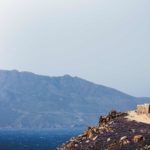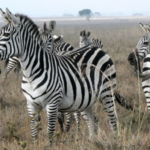Compiled by Richard Ammon
Globalgayz.com
Winter 2018
Ancient Sexualities
Colombia is no different than any other 20-21st century country in its staggered and fumbling progress to bringing equality among it citizens, be that gender, ethnicity, Indigenous or sexual orientation issues. After unsuccessful lobbying and persuasion of the congress for decades LGBT activists finally achieved success in parity of rights to countless homosexual citizens of Colombia. In 2016, despite great odds against the dominant Catholic tradition, Colombia became the 24th country in the world to allow full marriage equality. It was not a happy day for priests and their bigoted followers.
Both religion and sexuality are highly emotional issues that have to do with an individual’s identity and place in society. For centuries since the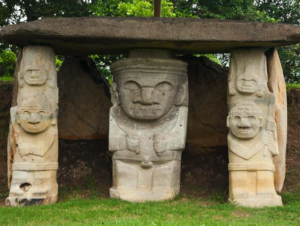 Spaniards invaded with their soldiers, guns and monks a new way of life was imposed on the native culture of Colombia. Traditional sexuality was suddenly revised, over one generation, and any form of sex outside heterosexual marriage was not just forbidden but persecuted. Countering this repressive and onerous religious influence in recent years Columbia has put in place laws allowing legality of homosexuality, same-sex adoption and anti-discrimination protections.
Spaniards invaded with their soldiers, guns and monks a new way of life was imposed on the native culture of Colombia. Traditional sexuality was suddenly revised, over one generation, and any form of sex outside heterosexual marriage was not just forbidden but persecuted. Countering this repressive and onerous religious influence in recent years Columbia has put in place laws allowing legality of homosexuality, same-sex adoption and anti-discrimination protections.
Recent legislation may be new but the existence of Colombian same-sex activity is ancient. Indigenous queerness predates the modern global LGBT framework. Queerness permeates not only Amazonia, but also the Americas at large. In Oaxaca, Mexico, Juchitán de Zaragoza is famous for its acceptance of “muxes” or mixed genders.
These quoted comments are edited from a report entitled ‘Sexual Modernity in Amazonia’
“In the US, Native Americans refer to sexual variation through the concept of Two-Spirits, and at least three tribes have formally recognized marriage equality for same-sex couples. Inter-governmental institutions now recognize indigenous queerness. On March 16 2013, the Inter-American Commission on Human Rights of the Organization of American States heard the testimonies of elected officials, regarding acknowledging of indigenous sexuality…Sexual diversity is intrinsically Indigenous.”
Most recently, in January 2018, The Inter-American Court of Human Rights reached a decision on a marriage equality petition submitted two years ago by Costa Rica. Twenty countries agreed to follow the court’s rulings when they signed the American Convention on Human Rights, (adopted by many countries in the Western Hemisphere in San José, Costa Rica, on 22 November 1969) including 16 which have not yet legalized same-sex marriage. These countries are Barbados, Bolivia, Chile, Costa Rica, the Dominican Republic, Ecuador, El Salvador, Guatemala, Haiti, Honduras, Mexico, Nicaragua, Panama, Paraguay, Peru and Suriname. As well, Argentina, Brazil, Colombia and Uruguay, who also follow the court’s decisions, have already legalized same-sex marriage.
Throughout South America there are small and numerous modern Pride festivals in small towns unheard of outside their rural native domains in Brazil, Peru, Colombia and beyond.
A wide-spread example is found among the Ticunas, one of the largest Indigenous groups in the Amazon realm. They have rules that respect same sex couples that form among different clans of the larger tribe. Sexual diversity is intrinsically Indigenous whereas sexual discrimination was brought in by a morality of invasive dogmatic evangelical (Christian) religions that stained the heritage of Indigenous sexuality. “Our ancestors experienced people living homo-affective lives but never interpreted it as something malicious, it is religion that came to interfere with our culture trying to evangelize us, arguing with a need to know God.”
“There is nothing foreign about sexual diversity in Amazonia”. It is not something current, not brought about by modern Gay Pride. It has long existed in Amazonia… It cannot be wrong; if it were it should have been since the beginning and not something new. Those are ancients who truly loved each other, who understood each other.” In several Amazonian ancient indigenous languages there are words for same-gender sex and affection.
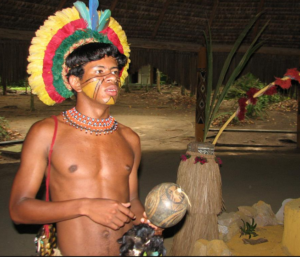
The ‘sexual revolution’ infuses cultures far beyond and before the modern western notion of ‘gay lib’. Amazon sexualities are not some eccentric tribal habits isolated from modernity. They are in fact the roots of sexual modernity; they are an inherent part of the global narratives of sexual rights. “Tikuna peoples are cosmopolitan while maintaining and valuing their origins.” Queerness exists in traditions and politics far beyond the modern modern western modes.
“‘Jungle queerness’ is a counter to the condescending ideas of Amazonia as an isolated wilderness scarcely inhabited by peoples without history. It reveals many communities that creatively negotiate LGBT ceremonies. their participation is as crucial links to global norms, to the global ‘scene’.; they are local systems of universal sexual truths. Just because they receive little notice (mostly in academia) they are nevertheless an inherent part of the tapestry of sexual varieties within our species that originates from ancient (pre-law-lingual) times. Looking far back (thousands of years) it is obvious that human sexual traditions predate human moral and civil codes, organized religions and concepts of binary sexuality— far beyond the Spanish/Catholic imposition of their European morality… Amazon sexualities reveal the complementarity of ancient and modern queer behavior in studying the sexual aspects of the evolution of human behavior.”
Observations of Ticuna people by Nelson Morales, professional photographer
“I discovered the Ticuna tribe, another homosexual community with strong similarities with the Oaxaca muxhes of the Oaxaca isthmus in Mexico. (The muxhes are part of a homosexual community that has transcended the idea of gender to assume an exaggerated female identity—based on the constant search for beauty. You might say they have developed a so-called “third gender.)”
I photographed the Ticuna world for several years. I was struck by how similar their Ticuna skin color was to the muxhes, how both tribes were preoccupied with th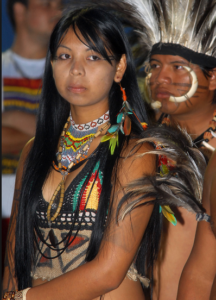 e accentuation of excess, and, above all, how the identities of both communities are shaped by femininity.
e accentuation of excess, and, above all, how the identities of both communities are shaped by femininity.
“The Ticuna have loudly campaigned for the right to be able to express their fluid gender, and to be seen and admired by others without prejudice. You see them in the jungle, wading in the river, walking down the streets in their villages, adding color and flavor to the region. Their community accepts them. Some work. Some study with the ambition of one day obtaining a degree. Others help their families with the housework.
Fifteen years ago, none of this kind of visibility would have happened in the Amazon jungle. Only recently—thanks to the influence of mass media—queer pride has taken a hold in these communities. I wanted to create portraits that transmitted the energy I found here—sensual, transgressive, and playful.” Read more about transgender tribes..
Modern Gay Scene
“The gay scene in Colombia has historically been more underground, but within just the past 10 years, the community has gained more support and the visibility has increased dramatically, particularly in the large cities like Bogota and Medellin. Gay pride celebrations and protests are now commonplace and large in these cities and the community has an active voice, which is not always common in this part of the world.”
“In Bogota and Medellin you’ll easily find a thriving nightlife scene and plenty of LGBT residents out and about looking to mix and mingle. Colombia’s biggest nightclub is located in Bogota as well as plenty of other bars and clubs where you can dance the night away. Thought slightly smaller, Medellin still has a thriving gay scene mostly centered in the area of Parque Lleras. And finally, Cartagena is host to Colombia’s largest gay party called Rumors Festival, held once a year which hosts visitors from around the world… Bogota has the biggest gay scene and also the largest nightclub in the country called Theatron. This club rivals that of some of Europe’s biggest and best.
Bogota is probably the most gay friendly city of Colombia. There is a neighborhood called Chapinero in Bogota called ‘Chapigay’. It’s near Calle 60 and caters for about anything for the LGTB community could want. From beauty salons, tattoo parlors, fashion shops, community centers, gay friendly travel agencies, sex clubs and of course bars, restaurants, discotheques. Many Colombians have progressive views but LGBTs still face some negative remarks or looks in the streets. On Thursdays El Mozo Club is a main destination. It has 2 floors, big music and busy with cut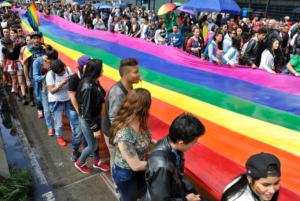 e guys. On Friday and especially on Saturday many go to Theatron, the biggest gay disco in Latin America. There are 10 discos. Remixes, dance, reggae every disco has his own kind of music. Outside on the square, people listen to live music and eat snacks.
e guys. On Friday and especially on Saturday many go to Theatron, the biggest gay disco in Latin America. There are 10 discos. Remixes, dance, reggae every disco has his own kind of music. Outside on the square, people listen to live music and eat snacks.
Medellin is Colombia’s second city and was once known as the center of the Colombian drug war during the 80’s and 90’s. It has shed this reputation and Medellin has grown up to be an highly functioning and modern city full of energy, culture, art and more. One of Colombia’s top destinations is the ocean-side city of Cartagena. This city was once a Spanish colony and its well preserved fortress on the water and its 16th century Castle of San Felipe de Barajas and the 17th century La Popa Convent.
Modern Homophobia
The following excerpt about persecution of LGBT people is excerpted from ‘Latin American New Dispatch’, April 15, 2017. “On the surface, Colombia appears to be at the vanguard of the gay rights movement, having extended legal rights to same-sex couples and transgender people. In 2007, the court recognized that LGBT Colombians had a right to own and inherit property. Less than two years later, it granted residency and nationality rights, housing subsidies and protection from domestic violence to same-sex couples. Last year, the court has also legalized equal marriage and adoption. Recently, judges also ruled in favor of a man in the city of Barranquilla who was repeatedly harassed by neighbors using homophobic slang against him.
“Nevertheless, for millions of other Colombians who are LGBT, these rulings and legislated rights have been largely meaningless as a result of deep-rooted prejudice that often results in violence. Jose Miguel Cañón, an LGBT activist for the Green Alliance Party, was used to constant insults and bullying from “Bloque Capital” gang since he started his activism job in 2007. But he had never been threatened at gunpoint before until now, he said. Bloque Capital, like other paramilitary organizations, want to cleanse society of homosexuality.
“Despite the warning, he continued working as an activist in his community, counseling other members of the LGBT community, organizing events to create awareness about LGBT issues and dissuading teenagers from joining the Bloque Capital gang. But after four months of constant threatening calls to his family’s house, he flew to the United States to seek political asylum in March 2013.
“Colombia has the world’s third highest number of U.S. asylum seekers, according to the Department of Homeland Security, applying under the category of “member of a particular social group.” Many are being persecuted on the basis of sexual orientation and gender identity.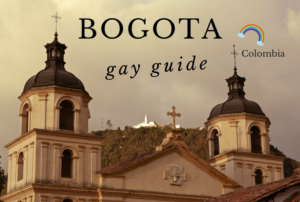
“Beyond facing the discrimination of a largely homophobic society, LGBT Colombians have also been actively persecuted by armed groups descended from Colombia’s 52-year-long conflict. Gay, bisexual and transgender people are four times more likely than the rest of the population to be threatened and abused by both legal and illegal armed forces, according to the Victims’ Unit, a state institution that keeps track of the armed conflict victims…”
Read the full story here about discrimination and violence against LGBT citizens:
latindispatch.com/2017/04/15/escaping-a-homophobic-war-in-colombia/
Links:
=Interview: https://nomadicboys.com/gay-life-in-colombia/
=https://www.tripadvisor.com/ShowTopic-g294073-i1708-k9812574-Gay_LGBT_Life_in_Colombia-Colombia.html
=http://www.guiagaycolombia.com/
=https://www.huffingtonpost.com/entry/colombia-lgbt-community_us_55db8b3ae4b04ae497042167
=http://www.e-ir.info/2015/07/02/sexual-modernity-in-amazonia/
=http://www.twobadtourists.com/2017/03/03/this-south-american-country-might-be-the-newest-emerging-gay-destination/

